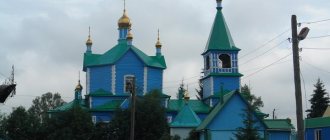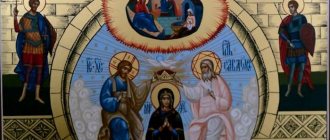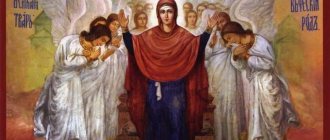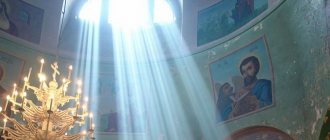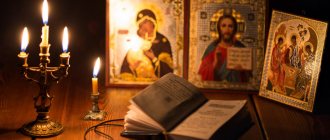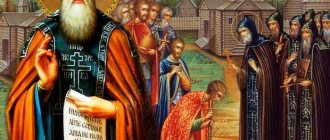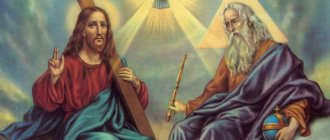The capital's Muslims asked to open prayer rooms in the subway and shopping centers. It is noted that this will allow believers to observe the fivefold prayer and not embarrass citizens in public places. The Department of Transport said that the appearance of such rooms in the Moscow subway is not being considered. At the same time, the State Duma stated that they were ready to discuss the proposal. We are looking into whether it is necessary to create prayer rooms in public places.
Photo: Moscow 24/Igor Ivanko
Great acts of prayer.
Many people forget about prayer in their room, in secret. And therefore they are deprived of great blessings. Through prayer we receive contact with heavenly powers.
One example from earthly life can show how important it is to use this secret room where very important service takes place: Electricity is usually produced by water that flows into the turbines of a power plant. There is one room in which you only need to turn one lever. It's just one simple action, but it releases a powerful flow of electrical energy and saturates the wires. The movement of the lever allows electricity to power the trains. Another lever saturates the entire city with electricity.
What happens at the power plant is hidden, and not many people think about this work.
Our prayer room is like this room in a power plant. In accordance with the great laws of God, the forces of God's grace are released there, which you can direct wherever you want. You can send them to your wife who is near you, to your friend who lives in another city or to your son who is far away from you. Like that man in the power plant who doesn't fully understand what's happening when he turns the levers, you show obedience to God's laws and it results in great action.
Also: Prayer is a powerful secret weapon.
CHAPEL
See what “PRAYER” is in other dictionaries:
chapel - See... Dictionary of synonyms
PRAYER - PRAYER, and, kind. pl. flax, female Premises for religious meetings, services and prayers (mainly among sectarians, non-Christians), prayer (prayer) house. Ozhegov's explanatory dictionary. S.I. Ozhegov, N.Yu. Shvedova. 1949 1992 ... Ozhegov's Explanatory Dictionary
chapel - chapel, c. pl. prayer and obsolete prayer ... Dictionary of difficulties of pronunciation and stress in modern Russian
chapel - f.; = prayer room, = prayer room, room for religious meetings and services (usually among sectarians and non-Christians). Ephraim's explanatory dictionary. T. F. Efremova. 2000 ... Modern explanatory dictionary of the Russian language by Efremova
prayer room - prayer room, prayer rooms, prayer rooms, prayer rooms, prayer room, prayer rooms, prayer room, prayer room, prayer room, prayer room, prayer room, prayer room, prayer room (Source: “Full accentuated paradigm according to A. A. Zaliznyak”) ... Forms of words
Prayer room - Prayer room in the Olenevsky monastery (photo of the end of the 19th century) Prayer room in Russia (especially among the Old Believers) a room for worship, a home church. In the royal mansions, the prayer room was also called the Cross Room. Does not have an altar and does not... ... Wikipedia
Chapel - a small church, private chapel (often in a house). (Architecture: an illustrated reference book, 2005) ... Architectural Dictionary
chapel - chapel, and, c. p.m. h. flax ... Russian spelling dictionary
chapel - (1 g); pl. mole / flax, R. mole / flax ... Spelling dictionary of the Russian language
prayer house - i, g. Booth, room for religious gatherings, meetings and prayer (translated into sectarians and non-Christians) ... Ukrainian Tlumach Dictionary
Source
Connection with God in the hidden.
It is important to make time for quiet time alone with God. There, behind a closed door, a connection with God opens. This can happen at any time of the day. Here you come in your prayers before the face of God. This should be a sincere and simple prayer. Then God and His angels are there too. In 1 Cor. 6:17 it is written that he who is united with the Lord is one spirit with the Lord. Here you can bring your children before Him, members of the Church, the sick and infirm. We have more and more topics to pray about. Even though we may feel terrible, nothing can break us when we hold on to Him. If you are active in this control room, then you are taking part in encouraging the people around you. Usually there is only one controller in the control room, but how many members of this prayer ministry are there?
Prayer is spiritual warfare. Don't get hung up on difficulties. Anxiety and various types of problems close our horizon. It's so easy to fall into a trap here. Turn to God for help, like the psalmist in Ps. 120:1-2: “I lift up my eyes to the mountains, from where my help will come. My help comes from the Lord, who created heaven and earth.” The result of prayer will be new strength and renewed spirit, and our success will be obvious to everyone.
Chapter 2. Prayer rooms and altars
Prayer rooms
Meaning
God is invisible; He can reveal Himself to us regardless of circumstances. To create an atmosphere more conducive to fellowship with Him, it is best to set aside a special place for prayer; it can be either beautifully designed or very simple.
Location
If possible, designate one room in the Church or home for prayer; if necessary, it can also be used as a living room. This will help us learn to serve others the same way we want to serve God and True Parents.
If it is not possible to allocate a special room, clear part of the largest room for the main place for prayer.
Purpose
Conducting services and daily use
Services can be held in a place specially designated for prayer.
It is good if parishioners pray in the designated place for prayer every day upon returning to church or home and before leaving church or home, but this is not necessary.
If desired, this tradition can be applied to any daily activity - for example, praying even before running out to the store. In this way, you will show Heavenly Father your desire to live in humility and purity of a sacrificial life, honoring Him even in the simplest, everyday situations. Thanks to this, you can feel strong spiritual support.
Maintenance of the prayer room
Clean your prayer area daily to develop a holy attitude towards it. Let this place be special, like the Consecrated Ground.
More attention needs to be paid to maintaining the prayer room. Beautiful drapes or curtains, fresh flowers and indoor plants, and special chairs with cushions will help you create an atmosphere of holiness.
Prayer Room Decorations
The prayer room can be decorated with a panel with the text “Family Vow” in Korean or the native language, as well as the symbol or flag of the Unification Church.
Prayer Room Etiquette
Bowing when entering and leaving the prayer room
In fact, there is no tradition that requires bowing when entering and leaving a prayer room. If you wish, you can bow (or bow your head respectfully, or bow from the waist). However, it is much more important than any external rituals to cultivate a heart of service and reverence during prayer.
Position during prayer
In the first chapter, which covers the etiquette of serving, you can find a detailed description of how to properly make a full bow. During prayer, it is most respectful to sit on your knees, but you can pray either sitting or standing. Congregants should remember that sitting in front of Heavenly Father and True Parents with their legs outstretched is disrespectful and indecent.
Altars
The meaning of the family altar
On August 15, 1985, True Parents victoriously completed their 40-year journey in the desert. This day was declared by True Father as the Day of Complete Victory.
In 2002, True Parents proclaimed the following motto for the year: “Mansey in honor of the successful establishment of a free, conflict-free and happy country of Universal peace and unity, the ideal of the Parents of heaven and earth!” Thus, the peaceful establishment of the Cheon Il Guk era was proclaimed.
May 5, 2004 became the Day of the unity of two principles and the victory of the number “ten” (Ssanhap Shchipsyn Il). On this day, True Parents declared the end of the era before the onset of Heaven and the beginning of the era after the onset of the Kingdom of Heaven. On this day the tradition of Anshiil days was founded.
The peaceful establishment of the Cheon Il Guk era means that the eternal God can now live with the central blessed families at their home. This brought real liberation to Heavenly Father's heart.
For the peaceful establishment of the Cheon Il Guk era, we must follow the family tradition of Hong Dok Hwe. By placing a photo of True Parents in our home, we express our readiness to serve them. By daily following the tradition of the family hundokhoe in front of the family altar, we proclaim and affirm the peaceful establishment of the Cheon Il Guk era.
Historically, the family altar is a tabernacle - a prototype of the Temple and a meeting place for the Jewish people with God. Therefore, for us, the family altar should be the most sacred place in the house. On the altar we place things given to us by God.
Before setting up a family altar, there are a few things to consider. Don't worry too much about whether it's pretty or too plain. Of course, the altar helps create a certain atmosphere, but the most important thing is the attitude with which we say the prayer. We speak with Heavenly Father in front of the altar, and for Him the purity of our souls during prayer is of greatest importance.
If you have difficulty installing the altar
For members or missionaries who move frequently, it may be difficult to establish a permanent altar. Of course, prayers and services can be held without an altar and without a photograph of True Parents. The most important thing in this case is your attitude; It is important to remember that you are dedicating this service or prayer to God and that it is not just an external ritual.
Temporary altar
If circumstances allow, carry with you a small photo of True Parents or any other items mentioned below; if desired, all this can be used to set up a temporary altar before prayer or service.
How to set up a family altar
If you want to install a permanent altar, you must first thoroughly clean the area designated for it, and then consecrate it with Holy Salt (see Chapter 17 “Holy Salt”, section “Practical Applications of Holy Salt: Rooms and Other Spaces”).
Place a clean tablecloth or piece of light-colored fabric on the “altar” (this could be a small table, bedside table, etc.). Place a photo of True Parents on top. On the altar you need to place a Cheon Il Guk candle, a box of special Holy Salt (for example, made by senior parishioners or received by one of the parishioners for the first time, and not one intended for everyday use), a vessel with Holy wine, the Divine Principle and Cheonsongyeon.
Previously, small photographs of Heung Jin-nim and Taemonim could also be placed on the altar if desired.
You can place flowers (preferably fresh) on the altar.
Attributes of a family altar
- The photograph of the True Parents is a symbol of the tablets, which personified the Messiah and the Holy Spirit for the Jews and were located in the Holy of Holies of the Tabernacle.
- Divine Principle and Cheonsongyong - God's Word to guide people.
- The Cheon Il Guk candle is a symbol of sacrifice. By burning for others, it protects us from Satan and helps create a holy atmosphere.
- Holy Wine and Holy Salt are attributes of Cheon Il Guk that all central blessed families should have.
- Holy wine is a symbol of the willingness to always convey the Blessing of True Parents to all people.
Practical issues of organizing a family altar
It is advisable to choose a special place in the room for the altar. It is best to install the altar near the north wall. However, if the location of doors or windows does not allow this, the altar can be placed near any wall. If possible, have him there permanently.
If the size of the room allows, then it is better to make a separate altar. Otherwise, you can use a separate shelf in a closet or other space that suits the purpose of the altar. You can also decide whether to cover the altar with a white tablecloth or not.
It is recommended that an official photograph of True Parents be placed on the altar. If you don't have one, use another photo of True Parents.
The box for Holy Salt should be small. It is desirable that it depicts the symbol of the Church.
A small darkened bottle can be used as a vessel for Holy Wine. You need to pour a small amount of Cheon Il Guk Holy Wine into it, which you need to take from the leaders of the Church. The remaining wine can be stored in the refrigerator.
Hongdokhwe in front of the family altar
Every morning, by the light of the lit Cheon Il Guk candle, the central blessed family participates in the Hong Doghwe tradition in front of the family altar, thus serving True Parents and establishing the peaceful establishment of the Cheon Il Guk era.
Offering table for Holy Days
On Holy Days, parishioners set the “offering table” by placing dishes and baskets of fruits, nuts, candies, etc. on the altar. (See Chapter 6, “Holy Days and Holidays,” section “Holy Days: Guidelines for Observing Holy Days at the Local, District, or National Level.”)
How to hang icons in the house?
Photo: Livemaster.ru
The order of icon placement is a tradition that must be strictly observed. There are several recommendations that can help you do everything right.
- The Orthodox cross is placed as high as possible. Above all icons without exception.
- There must be an icon of Jesus Christ in the center.
- Above it is the icon of the Holy Trinity.
- It is customary to hang an icon of the Mother of God to the right of Christ.
- Icons with saints are usually placed to the right and left of the Mother of God and the Savior.
- In Orthodoxy, Nicholas the Wonderworker is especially revered among the saints. Also popular are the apostles Peter and Paul, the prophet Elijah, and St. Sergius of Radonezh.
- A good addition would be icons of the Archangel Gabriel, John the Baptist, and the holy Evangelists.
- There are no strict requirements for which holy faces should be located in the red corner. Often they hang icons of saints who are considered their own patrons, whose names are borne by one of their relatives.
If necessary, you can consult with a priest so that the priest can suggest which icons to hang at home.

